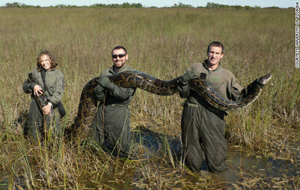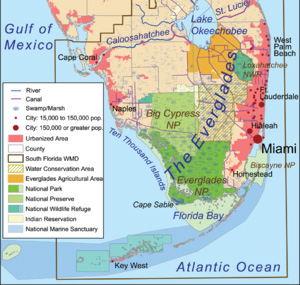redo Jump to...
print Print...
 (by Barbara Liston, YahooNews) ORLANDO, Florida (Reuters) – A python hunting competition starting on Saturday (January 12th) is drawing hundreds of amateurs armed with clubs, machetes and guns to the Florida Everglades, where captured Burmese pythons have exceeded the length of minivans and weighed as much as grown men.
(by Barbara Liston, YahooNews) ORLANDO, Florida (Reuters) – A python hunting competition starting on Saturday (January 12th) is drawing hundreds of amateurs armed with clubs, machetes and guns to the Florida Everglades, where captured Burmese pythons have exceeded the length of minivans and weighed as much as grown men.
Python Challenge 2013, a month-long event sponsored by the Florida Fish and Wildlife Conservation Commission, is open to hunters and non-hunters alike. …
“I just thought it was as exciting as could be. It’s a once-in-a-lifetime opportunity,” said contestant Ron Polster, a retired salesman from Ohio whose closest encounter with the swamp has been from the highway heading south for the winter.
Participants pay a $25 entry fee and take an online training course, which consists mostly of looking at photographs of both the targeted pythons and protected native snakes to learn the difference.
The state wildlife agency is offering prizes of $1,500 for the most pythons captured and $1,000 for the longest python.

University of Florida researchers capture a 15-foot python that was part of a radio-telemetry study in Everglades National Park. (image from CNN)
A Burmese python found in Florida last year set records as the largest ever captured in the state at 17-feet, 7-inches. The snake weighed nearly 165 pounds.
FWC spokeswoman Carli Segelson said the number of registered contestants reached about 500 this week and was growing, with people coming from 32 states.
The stated goal of the competition is to raise awareness of the threat Burmese pythons pose to the Everglades ecosystem. The snakes are native to Southeast Asia and have no known predators in Florida.
The contest also serves as a pilot program to determine whether regular hunting competitions can cull* the growing population of the invasive species, said Frank Mazzotti, a wildlife expert from the University of Florida who helped create the competition. [*cull – to reduce or control the size of (as a herd) by removal (as by hunting)]

Python Challenge rules require contestants to kill specimens on the spot in a humane fashion, recommending shooting the snakes precisely through the brain.
“I was hoping there would be a lot of machetes and not a lot of guns,” said Polster, the retired salesman. He said he worries “these idiots will be firing all over the place.”
… Segelson said the wildlife agency will provide training on the use of GPS devices and on identifying venomous snakes at the kick-off event. In the meantime, she said, contestants should be familiarizing themselves with the Everglades environment, just as they should before entering any other strange territory. …
By Reuters at YahooNews.com. Reprinted here for educational purposes only. Visit news.yahoo.com/florida-python-hunting-contest-draws-hundreds-233855237.html for the original post.
Questions
NOTE TO STUDENTS: Read the “Background” below before answering the questions.
1. a) What is the Python Challenge 2013? Be specific.
b) Who is sponsoring the competition?
2. What is the goal of the Python Challenge?
3. What will the competition help the Fish and Wildlive Commission determine?
4. How many people from how many states have entered the contest as of this week?
5. How did the Burmese python come to inhabit the Everglades?
6. Contestant Ron Polster of Ohio said of his fellow competitors: “I was hoping there would be a lot of machetes and not a lot of guns. [I’m concerned that] “these idiots will be firing all over the place.” What do you think of Mr. Polster’s decision to attend the competition when he regards other contestants from this viewpoint?
Background
BURMESE PYTHONS IN FLORIDA: Pythons can live up to 35 years and have anywhere from eight to 100 eggs, with the average female reproducing every other year. It is estimated that there are tens of thousands now in the Everglades.
- Burmese pythons are native to Southeast Asia, but accidental and deliberate release of snakes kept as pets in Florida have allowed them to find a new home there. They can grow up to 16 feet long and weigh up to 150 pounds. The first reports of Burmese pythons in the Florida Everglades began in the 1980s; a breeding population wasn’t confirmed there until 2000.
- Since then, the numbers of pythons sighted and captured in the Everglades have risen dramatically. According to Linda Friar with Everglades National Park, park personnel have captured or killed 1,825 pythons since 2000.
- Now researchers have shown that just as python populations established themselves, the native mammals of the regions began to decline – severely.
- People working in the Everglades knew they were seeing fewer mammals, but only when the hard numbers came in was it clear just how devastating the decline has been.
- “These were once very common animals in the Everglades, and now they’re gone,” says Michael Dorcas, a professor of biology at Davidson College in Davidson, N.C., and lead author on the paper.
- The pythons aren’t a danger to humans. The only known python attacks on humans in Florida have involved snakes kept as at-home pets, says Dorcas… Now coyotes and Florida panthers are believed to be affected, as well as birds and alligators.
- The loss of the mammals is devastating not only to those populations, but to all the animals that rely on them. It’s possible that the decline in bobcats, foxes, coyotes and panthers is linked to the disappearance of their typical prey: rabbits, raccoons and opossums.
- Pythons also are eating lots of birds. More than 25% of pythons found in the Everglades contain bird remains.
- They also happily eat pets, including cats, dogs and some farm animals. Roosters and geese have been found in their stomachs.
- And there’s not much that can be done. These snakes are “notoriously hard to find and very secretive,” Dorcas says. Because much of South Florida is a vast wilderness, the possibility of exterminating or even suppressing them doesn’t seem promising, he says. “It’s an ecological mess, and exactly what’s going to happen down the road remains to be seen.”
- On Jan. 23, the U.S. Fish and Wildlife Service started the paperwork to ban the importation and interstate transportation of Burmese pythons, northern and southern African pythons and the yellow anaconda because they threaten the Everglades and other sensitive ecosystems. These snakes are being listed as injurious species under the Lacey Act.
- How far the snakes might expand their range is unknown. Research in 2008 showed they could possibly survive across the entire southern United States.
- And research this month showed they could survive in saltwater, which had previously been believed to be a barrier to their expansion.
- “All of Florida and much of the coastal plain of the southeastern United States is suitable habitat,” Dorcas says. (from a January 2012 usatoday article)
Resources
View the website at pythonchallenge.org.
Daily “Answers” emails are provided for Daily News Articles, Tuesday’s World Events and Friday’s News Quiz.



